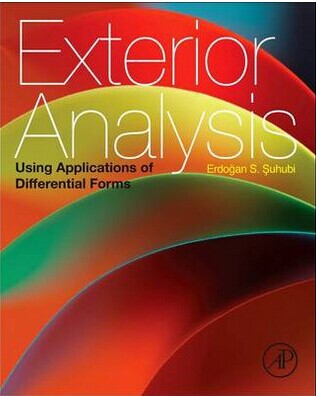
Exterior Analysis: Using Applications of Differential Forms
[BOOK DESCRIPTION]
Exterior analysis uses differential forms (a mathematical technique) to analyze curves, surfaces, and structures. Exterior Analysis is a first-of-its-kind resource that uses applications of differential forms, offering a mathematical approach to solve problems in defining a precise measurement to ensure structural integrity. The book provides methods to study different types of equations and offers detailed explanations of fundamental theories and techniques to obtain concrete solutions to determine symmetry. It is a useful tool for structural, mechanical and electrical engineers, as well as physicists and mathematicians. It provides a thorough explanation of how to apply differential equations to solve real-world engineering problems. It helps researchers in mathematics, science, and engineering develop skills needed to implement mathematical techniques in their research. It includes physical applications and methods used to solve practical problems to determine symmetry.
[TABLE OF CONTENTS]
Preface ix
Chapter I Exterior Algebra
1.1 Scope of the Chapter 1 (1)
1.2 Linear Vector Spaces 2 (17)
1.3 Multilinear Functional 19 (5)
1.4 Alternating k-Linear Functional 24 (9)
1.5 Exterior Algebra 33 (4)
1.6 Rank of an Exterior Form 37 (14)
Exercises 46 (5)
Chapter II Differentiable Manifolds
2.1 Scope of the Chapter 51 (1)
2.2 Differentiable Manifolds 52 (41)
2.3 Differentiable Mappings 93 (10)
2.4 Submanifolds 103(7)
2.5 Differentiable Curves 110(2)
2.6 Vectors. Tangent Spaces 112(8)
2.7 Differential of a Map Between 120(6)
Manifolds
2.8 Vector Fields. Tangent Bundle 126(7)
2.9 Flows over Manifolds 133(9)
2.10 Lie Derivative 142(11)
2.11 Distributions. The Frobenius Theorem 153(22)
Exercises 168(7)
Chapter III Lie Groups
3.1 Scope of the Chapter 175(1)
3.2 Lie Groups 175(5)
3.3 Lie Algebras 180(7)
3.4 Lie Group Homomorphisms 187(2)
3.5 One-Parameter Subgroups 189(5)
3.6 Adjoint Representation 194(3)
3.7 Lie Transformation Groups 197(10)
Exercises 200(7)
Chapter IV Tensor Fields On Manifolds
4.1 Scope of the Chapter 207(1)
4.2 Cotangent Bundle 208(1)
4.3 Tensor Fields 209(10)
Exercises 216(3)
Chapter V Exterior Differential Forms
5.1 Scope of the Chapter 219(1)
5.2 Exterior Differential Forms 220(4)
5.3 Some Algebraic Properties 224(2)
5.4 Interior Product 226(10)
5.5 Bases Induced by the Volume Form 236(8)
5.6 Ideals of the Exterior Algebra 244(9)
Λ(M)
5.7 Exterior Forms under Mappings 253(7)
5.8 Exterior Derivative 260(9)
5.9 Riemannian Manifolds. Hodge Dual 269(17)
5.10 Closed Ideals 286(4)
5.11 Lie Derivatives of Exterior Forms 290(11)
5.12 Isovector Fields of Ideals 301(5)
5.13 Exterior System and Their Solutions 306(11)
5.14 Forms Defined on a Lie Group 317(10)
Exercises 321(6)
Chapter VI Homotopy Operator
6.1 Scope of the Chapter 327(1)
6.2 Star-Shaped Regions 327(3)
6.3 Homotopy Operator 330(6)
6.4 Exact and Antiexact Forms 336(4)
6.5 Change of Centre 340(1)
6.6 Canonical Forms of 1-Forms, Closed 341(11)
2-Forms
6.7 An Exterior Differential Equation 352(3)
6.8 A System of Exterior Differential 355(10)
Equations
Exercises 363(2)
Chapter VII Linear Connections
7.1 Scope of the Chapter 365(1)
7.2 Connections on Manifolds 366(11)
7.3 Cartan Connection 377(11)
7.4 Levi-Civita Connection 388(10)
7.5 Differential Operators 398(7)
Exercises 401(4)
Chapter VIII Integration Of Exterior Forms
8.1 Scope of the Chapter 405(1)
8.2 Orientable Manifolds 406(8)
8.3 Integration of Forms in the Euclidean 414(2)
Space
8.4 Simplices and Chains 416(7)
8.5 Integration of Forms on Manifolds 423(6)
8.6 The Stokes Theorem 429(17)
8.7 Conservation Laws 446(13)
8.8 The Cohomology of de Rham 459(17)
8.9 Harmonic Forms. Theory of Hodge-de 476(6)
Rham
8.10 Poincare Duality 482(5)
Exercises 484(3)
Chapter IX Partial Differential Equations
9.1 Scope of the Chapter 487(1)
9.2 Ideals Formed by Differential 488(12)
Equations
9.3 Isovector Fields of the Contact Ideal 500(20)
9.4 Isovector Fields of Balance Ideals 520(43)
9.5 Similarity Solutions 563(6)
9.6 The Method of Generalised 569(15)
Characteristics
9.7 Horizontal Ideals and Their Solutions 584(20)
9.8 Equivalence Transformations 604(53)
Exercises 655(2)
Chapter X Calculus Of Variations
10.1 Scope of the Chapter 657(1)
10.2 Stationary Functional 657(4)
10.3 Euler-Lagrange Equations 661(9)
10.4 Noetherian Vector Fields 670(9)
10.5 Variational Problem for a General 679(16)
Action Functional
Exercises 693(2)
Chapter XI Some Physical Applications
11.1 Scope of the Chapter 695(1)
11.2 Conservative Mechanics 696(9)
11.3 Poisson Bracket of 1-Forms and 705(5)
Smooth Functions
11.4 Canonical Transformations 710(6)
11.5 Non-Conservative Mechanics 716(15)
11.6 Electromagnetism 731(11)
11.7 Thermodynamics 742(9)
Exercises 748(3)
References 751(4)
Index Of Symbols 755(2)
Name Index 757(2)
Subject Index 759

 新书报道
新书报道